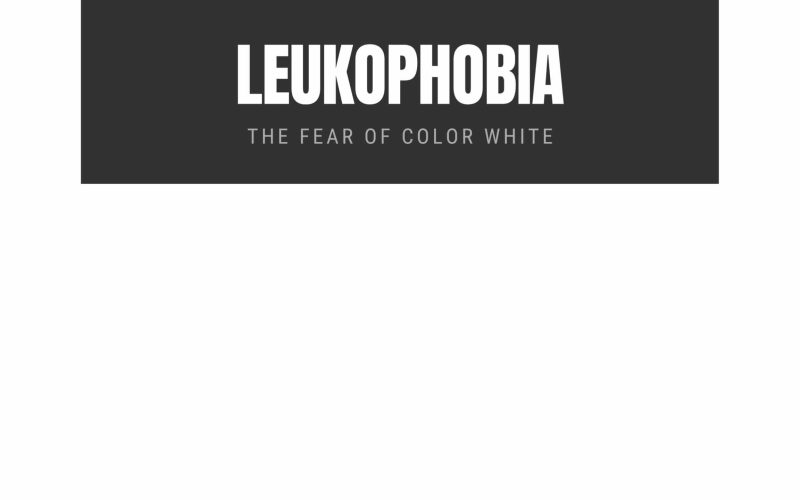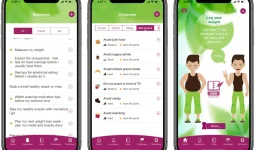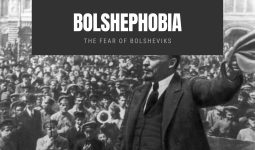The unreasonable fear of the color white is leukophobia. Someone suffering from this disorder should expect a very high degree of anxiety from simply thinking about the color white, not to mention seeing it in real life.
Generally, people with leukophobia may experience severe anxiety levels that may result in a full-blown panic attack.
While such an influx of anxiety would not always be the case for those who have leukophobia, it is still quite possible.
Among some other signs, anyone having a full-blown panic attack due to their leukophobia may expect to have an elevated heart rate, an increased breathing rate, higher blood pressure, muscle tension, shaking, and excessive sweating.
While panic attacks may not always be the case for anyone with leukophobia symptoms, they may still occur, especially if their symptoms are very serious.
Someone with leukophobia may find themselves avoiding what they are afraid of (color white). By ensuring that they can not in any way be exposed to the color white, they can take this to the extreme.
Someone with this disorder, for instance, can refuse to own something that has the color white in it in their home.
One of the major causes of their psychological trauma is likely to be triggered by undue concern and irrational thoughts.
While individuals with this condition can actively suppress their fear to help them minimize their risk of feeling any acute anxiety, this can also intensify their long-term leukophobia symptoms because by actively avoiding it, they can also validate their fear to themselves.
Symptoms of Leukophobia
As with almost any other phobia that occurs, someone with leukophobia would expect the most noticeable symptom of their disorder to be anxiety. As previously stated, their distress can also be so intense that they can also experience full-blown panic attacks as a result.
They might also have to be hospitalized, depending on the extent of their panic attack. However, this will vary from person to person and will be based on several variables.
Also, someone with leukophobia can undertake painstaking efforts to ensure they do not in any way come in contact with what might trigger them.
This may suggest that they avoid places that may expose them to their fear and that they can consciously try to prevent it by taking a more hands-on approach.
You’ll see some more common leukophobia symptoms below:
- Anxiety
- Avoiding the color white continuously
- Unable to deal with their fear
- Sweating, muscle tension, and shakiness
- Panic attacks
Causes of Leukophobia
Leukophobia does not have any definitive causes. Nevertheless, genetics and one’s environment can play very important roles in developing this disorder.
For instance, someone with a family history of mental illness, especially anxiety disorders or particular phobias, might be more likely to experience leukophobia. They can then be genetically predisposed to experience mental illness typically.
If anyone were to have such genetics, for them to develop full-blown leukophobia, it might just require that they undergo some traumatic incident.
Some emotionally traumatic occurrences that, in some way, include the different fears associated with leukophobia might be necessary for anyone to acquire this disorder as long as they have the correct genetics.
Most mental health practitioners’ opinion is that both environmental and genetic factors play a crucial role in developing any given mental illness, even though we do not know the exact causes of leukophobia.
Therefore, examining these two distinct criteria closer will help determine whether you might be at risk of developing leukophobia.
Treatments of Leukophobia
Just as there are no confirmed causes of leukophobia, we have no specially formulated treatments for this condition.
However, several different types of care are still available, which may greatly relieve many of the symptoms of leukophobia.
Cognitive-behavioral therapy ( CBT), exposure therapy, and some psychiatric drugs, among others, are some of these treatments.
Exposure Therapy
Exposure therapy is one of the most effective approaches to treating anxiety disorders, such as leukophobia.
It can be an effective way of helping the patient desensitize to their fears. Nevertheless, the therapist must be qualified before attending to the patient.
For instance, if the therapist were to introduce someone with leukophobia to their anxiety marginally, it would not be very successful because they would require a larger amount of exposure to induce any meaningful patient shift.
The same can be said for this scenario’s antithesis. Suppose the therapist were to expose someone with leukophobia to their anxiety unnecessarily.
In that case, doing so might be extremely detrimental to the extent that, because of the therapy itself, their leukophobia could become significantly worse.
It is also important that for someone with leukophobia, the practitioner implementing exposure therapy has a very good understanding of how serious their symptoms are to recognize the amount of exposure that the patient is likely to tolerate.
Working Out
For people who suffer from anxiety disorders, including leukophobia, exercise is highly helpful. Cardiovascular exercise, in particular, can greatly help alleviate stress.
This is not to suggest that training for weight resistance does not help anyone with anxiety. Still, aerobic exercise is more useful in producing certain chemicals, such as endorphins, that help the brain function better.
According to the American Psychology Association, physical activity can help condition the mind to better deal with stressful conditions. This makes sense, considering the high-stress level the body experiences during strenuous exercise.
So, if you are sedentary yourself, then involvement in some aerobic exercise will substantially reduce your leukophobia symptoms by making it much easier for you to deal with the anxiety and stress associated with this disorder.
Different aerobic modalities, such as biking, swimming, skiing, jogging, and walking, can be very helpful in reducing the symptoms of leukophobia.
By playing sports such as tennis, basketball, soccer, and racquetball, you can also benefit from the many advantages of exercise, among many other sports.
Consistently participating in some form of exercise will help alleviate some of the pain associated with leukophobia with time.
Yoga Sessions
Several yoga poses can significantly help anyone with leukophobia. This is in part due to the meditative state of mind that yoga tends to generate consistently in those who practice it.
It is possible to think of yoga as meditation in motion. It will help alleviate some of the anxiety associated with the fear of white because your mind can focus on something more positive by engaging in yoga.
Several forms of yoga, such as hot yoga or hatha yoga, can help anyone with leukophobia. Additionally, nearly all of them can help alleviate some of the tension and anxiety associated with leukophobia, regardless of the many different types of yoga that exist.
For individuals who have never practiced yoga before, classes or watching directed videos that can assist you through each pose might be in their best interest. The more you practice yoga, the more adept you will become at it, much like with meditation.
You should also expect to achieve improved strength and endurance, among other advantages, and help you reduce the symptoms of leukophobia.
Mindfulness-Based Stress Reduction (MBSR)
MBSR is an 8-week evidence-based curriculum that includes secular, comprehensive instruction in mindfulness to assist people with anxiety, depression, stress, and other kinds of mental distress.
As mindfulness meditation is very effective for anxious people, MBSR may substantially benefit someone who has leukophobia.
Someone with leukophobia should expect to acquire a wide variety of skills through such a standardized program that can enable them to alleviate the extreme fear associated with their particular phobia.
Consult with a doctor or therapist to see if MBSR can help minimize the severity of your leukophobia symptoms and where to find MBSR services in your area.
Psychiatric Medications
Anti-anxiety Meds
To help avoid panic attacks, these kinds of drugs are very useful.
Because persons with phobias quite frequently experience panic attacks, such medications can be particularly helpful for people who have a severe form of leukophobia.
Valium, Xanax, and Klonopin, among many others, are some popular anti-anxiety drugs.
These medications are usually not administered regularly, but it depends on the severity of the fear of white.
However, before you decide to take any anti-anxiety medications, this is something that you should first address with your specialist to ensure that it is safe and reliable.
Antidepressants
These types of medications aren’t only for people who suffer from depression, as they can also help people suffering from anxiety disorders as well, such as leukophobia. Some common antidepressants are Paxil, Zoloft, and Lexapro, among several others.
These drugs may be able to help reduce some of the symptoms of leukophobia.
Cognitive Behavioral Therapy (CBT)
A psycho-social intervention aimed at improving one’s mental health is CBT. It is a tool that is commonly utilized to treat individuals with anxiety disorders such as OCD and generalized anxiety disorder.
People with leukophobia can also profit from CBT and see how it will help them understand far more why they think and act the way they do about their irrational fears.
Given the sheer automaticity of its symptoms, CBT can be extremely beneficial for anyone with leukophobia.
For instance, they will almost always have an immediate, subconscious reaction to their fear when someone with leukophobia is exposed to their fear.
Such a lack of introspection may be a significant part of why anyone with this disorder will struggle to the degree they do.
CBT will help you step back and more thoroughly examine your worries than usual. In addition to learning to be more fastidious about recognizing one’s particular fears, someone participating in CBT with leukophobia may also expect to develop various other skills to help alleviate the distress induced by their disease.
Dialectical Behavior Therapy (DBT)
For individuals dealing with emotion control, DBT is a very successful method of care. It is also used to treat people with borderline personality disorder who suffer from it.
However, for those suffering from anxiety disorders like leukophobia, it may also be rather advantageous.
This is due to the many coping abilities that you would expect to acquire in a DBT community. Usually, these groups last for about half a year and may have two individuals to many individuals, depending on how many people are willing to participate.
Half-smiling is one very useful DBT skill for supporting those with leukophobia. This method makes you think about what you fear or disturb you while smiling softly, slightly raising the corners of your mouth, hence the word “half-smiling.”
But it is not enough to think about your fear while half-smiling. You also have to try to avoid entertaining certain painful emotions that might evoke your particular fear.
Mindfulness meditation is also widely used in DBT, and as it is done in a group setting, it can greatly benefit someone with leukophobia, which helps to put the patient out of their comfort zone.
Drinking hot tea to harness the sense of taste or simply focusing on breathing may be included in these group mindfulness practices.
Another very valuable DBT attribute that can assist those with leukophobia is coping ahead. You would want to find a place to settle down peacefully without distraction by coping ahead.
Close your eyes, and then think of the many different potential situations you can face and resolve or cope with your particular fear.
If you are exposed to the particular fear associated with it in real life, doing so will allow you to be even more adept at dealing with your fear of white.
Meditation Practice for Leukophobia
For anyone suffering from leukophobia, several useful meditations exist that can be very useful. In particular, mindfulness meditation has proven to be very effective in helping individuals to reach a more calm state.
There are different ways to practice mindfulness meditation, and several meditation apps are designed to make it as simple as possible.
Mindfulness has the power to benefit those who have leukophobia greatly because how it can encourage them to distract themselves from their anxiety by refocusing their attention on something else that does not have any emotional baggage attached to it.
This may include concentrating on your breathing. This is one of the most fundamental ways to meditate, be fully aware of their environment, and be in control.
In the middle of a panic attack, for someone with leukophobia, redirecting one ‘s mind to the different sensations felt. Simultaneously, breathing will potentially help minimize the amount of emotional distress encountered during such an outburst of anxiety.
You will implement mindfulness meditation by paying careful attention to how the muscles in your stomach and lungs contract and relax with each inhale and exhale. It would help if you spent time reflecting on how it feels as your chest expands and how it sinks in with each exhale.
It would be best if you concentrated on the sounds around you, the way your skin feels when you touch certain things, the way foods taste, and the way certain aromas smell, in addition to concentrating on your breathing.
It will greatly enable you to minimize some of the anxiety associated with leukophobia by tapping into your five senses. Also, note that being an adept meditator will take a lot of practice. So, constant practice is necessary.
Control Caffeine Consumption
It is no secret that the consumption of large quantities of caffeine triggers anxiety during the day. This makes sense as we look closely at how caffeine controls the physiology of our body.
When we ingest a high dose of caffeine, our heart starts to beat more rapidly, and we become tenser. This can push our body into a “fight or flight” mode. For those with leukophobia to experience panic attacks, such a state of mind is also a precursor.
Therefore, consuming little to no caffeine during the day will substantially help decrease your daily anxiety.
While doing so would certainly not make all of your distress go away, if you were to drink a significant amount of caffeine, it would also allow you to minimize any needless pain you would have endured otherwise.
Certain energy drinks, as well as beverages like coffee and tea, are high in caffeine. Some foods, including dark chocolate, also contain caffeine. Being more mindful of your daily caffeine intake will reduce some of the leukophobia-related symptoms.
If you suspect you are experiencing discomfort with white colors or objects, consult your medical doctor or therapist for a proper diagnosis. This fear is indeed irrational, but it is very justified.








